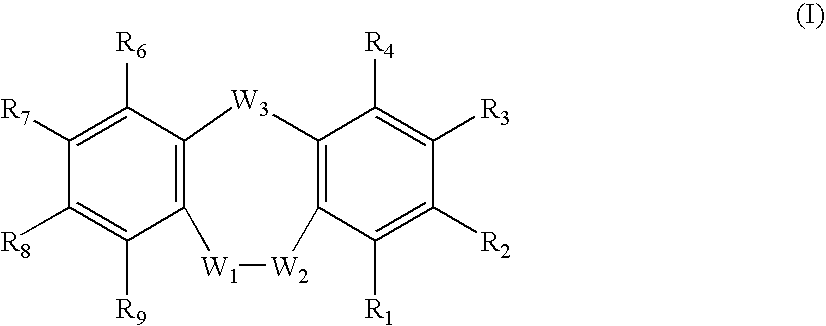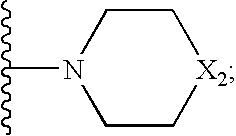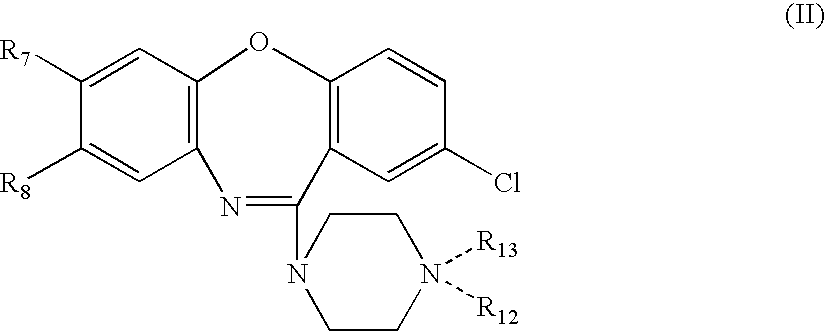Compounds and uses thereof
a technology of compounds and compounds, applied in the field of immunoinflammatory disorders, can solve the problems of antidepressants without any therapeutic benefits, possible severe adverse effects, and untrue antidepressants, and achieve the effects of reducing the risk of infection
- Summary
- Abstract
- Description
- Claims
- Application Information
AI Technical Summary
Benefits of technology
Problems solved by technology
Method used
Image
Examples
example 1
Protection and Deprotection of Reactive Groups
[0253] The synthesis of conjugates and charge-modified antidepressants may involve the selective protection and deprotection of alcohols, amines, ketones, sulfhydryls or carboxyl functional groups of the parent antidepressant, the linker, the bulky group, and / or the charged group. For example, commonly used protecting groups for amines include carbamates, such as tert-butyl, benzyl, 2,2,2-trichloroethyl, 2-trimethylsilylethyl, 9-fluorenylmethyl, allyl, and m-nitrophenyl. Other commonly used protecting groups for amines include amides, such as formamides, acetamides, trifluoroacetamides, sulfonamides, trifluoromethanesulfonyl amides, trimethylsilylethanesulfonamides, and tert-butylsulfonyl amides. Examples of commonly used protecting groups for carboxyls include esters, such as methyl, ethyl, tert-butyl, 9-fluorenylmethyl, 2-(trimethylsilyl)ethoxy methyl, benzyl, diphenylmethyl, O-nitrobenzyl, ortho-esters, and halo-esters. Examples of c...
example 2
Preparation of Hydroxylated Tricyclic Antidepressants
[0254] The selective hydroxylation of tricyclic antidepressants can be achieved enzymatically using available methods. For example, in vitro methods for the hydroxylation of clomipramine, see Nielsen et al., J. Pharmacol. Exp. Ther. 277:1659 (1996); amitriptyline, see Zhang et al., Drug Metab. Dispos. 23:1417 (1995); doxepine, see Moody et al., Drug Metab. Dispos. 27:1157 (1999); and amoxapine, see Moody et al., Appl. Environ. Microbiol. 66:3646 (2000); have been described. The tricyclic antidepressant can be incubated in the presence of, for example, Cunninghamella elegans, liver microsomes, or P450 enzyme, e.g., CYP3A4 (Research Diagnostics, Inc., product number RDI-CYP3A4). The resulting mixture of hydroxylation products can be separated using HPLC. Alternatively, the hydroxylated tricyclic antidepressant can be prepared synthetically, for example, as described in Example 3.
example 3
Preparation 8-Hydroxyamoxapine
[0255] 8-hydroxyamoxapine can be synthesized as shown in Scheme 1.
PUM
| Property | Measurement | Unit |
|---|---|---|
| time | aaaaa | aaaaa |
| time | aaaaa | aaaaa |
| time | aaaaa | aaaaa |
Abstract
Description
Claims
Application Information
 Login to View More
Login to View More - R&D
- Intellectual Property
- Life Sciences
- Materials
- Tech Scout
- Unparalleled Data Quality
- Higher Quality Content
- 60% Fewer Hallucinations
Browse by: Latest US Patents, China's latest patents, Technical Efficacy Thesaurus, Application Domain, Technology Topic, Popular Technical Reports.
© 2025 PatSnap. All rights reserved.Legal|Privacy policy|Modern Slavery Act Transparency Statement|Sitemap|About US| Contact US: help@patsnap.com



